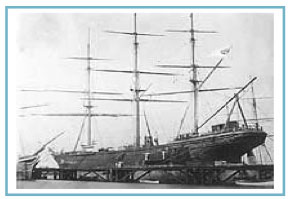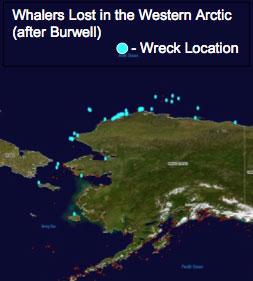 |
 |
 Error processing SSI file
Error processing SSI file
|
The Office of National Marine Sanctuaries' Interest
in the Lost Whaling Fleets of the Western Arctic
 |
|
The CSS Shenandoah, hauled into drydock for repairs in Melbourne, Australia, February 1865. (Photo: U.S. Naval Historical Center)
|
As mandated in the National Marine Sanctuary Act, NOAA's National Marine Sanctuary Program is responsible for effective stewardship of America's maritime heritage resources. Working in collaboration
with the State of Alaska Office of History and Archaeology and others, the NMSP Maritime
Heritage Program is bringing additional resources and assets to support this
fascinating and important work. Maritime archaeologists and historians employed by
NOAA are already involved in whaling heritage survey and preservation efforts
across the nation. For NOAA, the Lost Whaling Fleets of the Western Arctic represent a featured partnership project
within the context of our larger national whaling narrative. As regards the 1871 and 1876 disasters, NOAA seeks to work in
collaboration with local researchers in Alaska, bringing new platforms and advanced underwater technologies to the
ongoing investigation.
 |
|
Whalers Lost in the Western Arctic
|
Ships conducting offshore magnetometer and side scan sonar surveys, and aerial Light Detection and
Ranging (LIDAR) flights will both provide essential information on what remains of these lost whaling vessels. Also, NOAA will help
interpret and communicate these events to a national audience, bringing the considerable
experience and expertise of the NOAA National Marine Sanctuary education,
outreach and communication staff with Web- based education and outreach, video production and telepresence to help tell the
story.
As for what were, at the end of June in 1865, For Further Information,
contact: Brad.Barr@noaa.gov
the brightly-burning American whaling vessels
the SHENANDOAH left in its wake,
background research is being conducted,
potential partners being identified, and
preliminary planning for what field surveys
might be undertaken in coming years is in the
very early stages of development. This
research continues and expands NOAA's long
involvement with Civil War history and heritage
at the MONITOR National Marine Sanctuary.
Through this work in some of the most remote
places on Earth, the NOAA's Marine
Sanctuary Program will tie together places
emblematic of our whaling heritage - New
Bedford, Nantucket, Hawaii and California -
through national marine sanctuaries
associated with these stories from our whaling
past. NOAA will weave together these
compelling accounts of the icebound whaling
fleets of the 1870's and the epic story of the
SHENANDOAH with what is learned from field
research conducted by NOAA and its partners
to enhance and expand the American public's
understanding and appreciation this
historically significant chapter of America's
maritime history.
|
|
|
 |